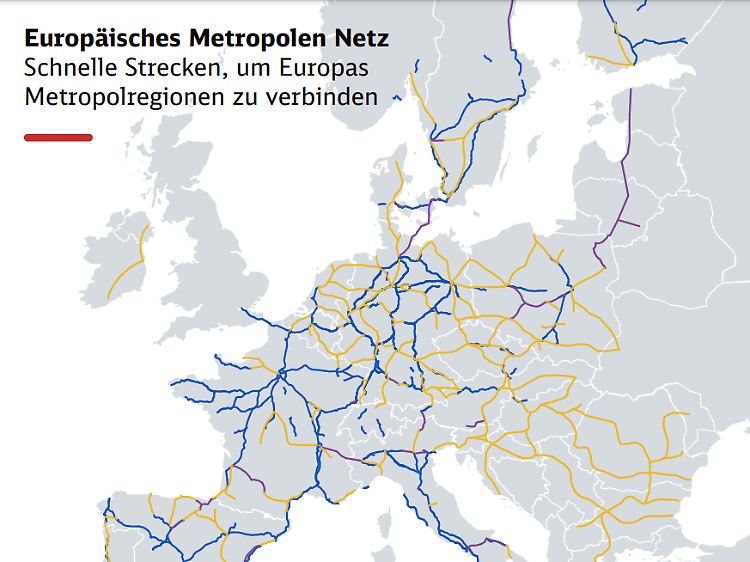At 300 km/h across the continent
This is what Europe’s high-speed rail network could look like
07/08/2023 11:53 am
Europe’s railways are proposing a radical expansion of the high-speed network to reduce CO₂ emissions. By 2050, traffic with fast trains is to be tripled. This would also mean an expansion of the route network for Germany.
Together with European partner railways, Deutsche Bahn (DB) has drawn up a study on the expansion of high-speed transport (HGV) in Europe. With a doubling by 2030 and a tripling by 2050, the European HGV should make an important contribution to reducing CO₂ in the transport sector, as DB explained. For this, a total of 21,000 kilometers of rail network would have to be built and expanded across Europe.
Especially for southern and eastern Europe, the availability of high-speed trains would increase enormously.
(Photo: DB AG)
The proposal under the title “Metropolitan Network” includes the concrete route extension for fast passenger trains on the entire continent and the simulation of the possible increase in traffic on environmentally friendly rail. The starting point of the study is therefore the EU climate program “Green Deal”. In the study, the specialists analyzed what such a “Green Deal” network would have to look like in order to achieve the EU goals.
“A tripling of high-speed traffic in Europe is possible,” emphasized DB Board Member for Long-Distance Passenger Transport, Michael Peterson. “If the infrastructure is there, millions of people on the continent will benefit from attractive connections and shorter travel times.” He added: “The railway countries in Central and Western Europe and even more so in Southern and Eastern Europe benefit from this in particular.”
Hourly connection
According to the study, the planned “Metropolitan Network” should connect all 230 metropolitan regions and the large cities in Europe to the HGV at least every hour. Cities with more than 250,000 inhabitants are considered metropolitan regions. Around 60 percent of the people in Europe live in the metropolitan regions and thus have direct access to the HGV – even in regions where there is still no fast rail traffic.
To do this, “the EU and the member states would have to make considerable additional investments and invest in network expansion throughout Europe”. The routes designed for the HGV would almost triple from today’s 11,300 kilometers to 32,000 kilometers by 2050. The network should enable speeds of 300 km/h.
Poland’s network would increase more than tenfold
According to Deutsche Bahn, this means for Germany that if the route were expanded, including the routes already under construction and planned, the high-speed infrastructure in this country would increase to a good 6,000 kilometers. Poland would also be a winner, as it would increase its network more than tenfold from today’s 224 kilometers by 2760 kilometers.
The railways involved want to exchange ideas with politicians next autumn, as the DB said. The infrastructure measures currently being planned or under construction are not sufficient to achieve a doubling of high-speed traffic by 2030.
